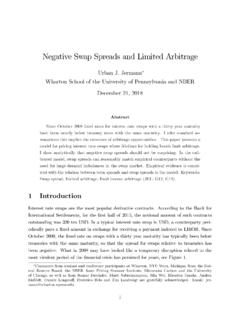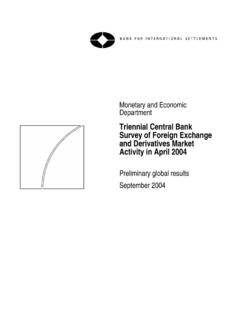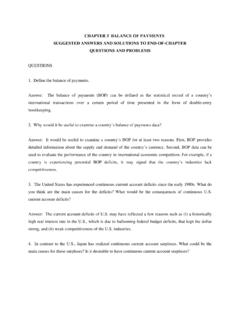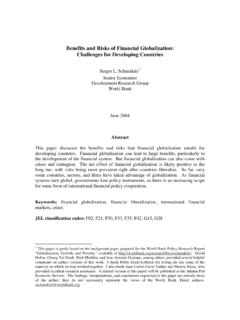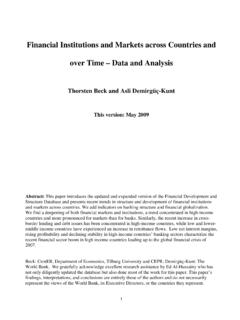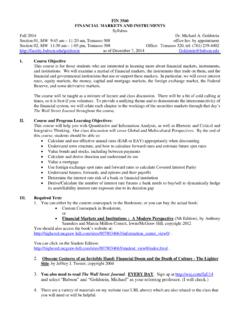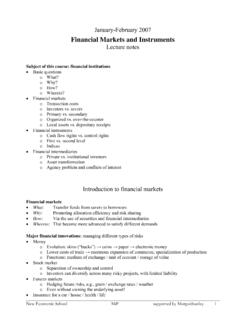Transcription of Financial Intermediaries and Markets - Wharton Finance
1 FinancialInstitutionsCenterFinancial Intermediaries and MarketsbyFranklin AllenDouglas Gale00-44-CThe Wharton Financial institutions CenterThe Wharton Financial institutions Center provides a multi-disciplinary research approach tothe problems and opportunities facing the Financial services industry in its search forcompetitive excellence. The Center's research focuses on the issues related to managing riskat the firm level as well as ways to improve productivity and Center fosters the development of a community of faculty, visiting scholars and whose research interests complement and support the mission of the Center.
2 TheCenter works closely with industry executives and practitioners to ensure that its research isinformed by the operating realities and competitive demands facing industry participants asthey pursue competitive of the working papers summarized here are available from the Center. If you wouldlike to learn more about the Center or become a member of our research community, pleaselet us know of your AllenRichard J. HerringCo-DirectorCo-DirectorThe Working Paper Series is made possible by a generousgrant from the Alfred P. Sloan FoundationFinancial Intermediaries and MarketsFranklin AllenDepartment of FinanceWharton SchoolUniversity of PennsylvaniaPhiladelphia, PA GaleDepartment of EconomicsNew York University269 Mercer StreetNew York, NY 5, 2003 AbstractAcomplexfinancial system comprises bothfinancial Markets andfinancial distinguishfinancial Intermediaries according to whether they issue complete contingentcontracts or incomplete contracts.
3 Intermediaries such as banks that issue incomplete con-tracts, , demand deposits, are subject to runs, but this does not imply a market sophisticatedfinancial system a system with complete Markets for aggregate risk andlimited market participation is incentive-efficient, if the Intermediaries issue complete con-tingent contracts, or else constrained-efficient, if they issue incomplete contracts. We arguethat there may be a role for regulating liquidity provision in an economy in which marketsfor aggregate risks are Markets , Intermediaries and crisesFor a long time, it has been taken as axiomatic thatfinancial crises are best avoided.
4 Weconfront this conventional wisdom by showing that, under certain conditions, a laisser-fairefinancial system achieves the incentive-efficient or constrained-efficient allocation. Further-more, constrained efficiency may requirefinancial crises in equilibrium. The assumptionsneeded to achieve these efficiency results are restrictive, but no more so than the assump-tions normally required to ensure Pareto-efficiency of Walrasian equilibrium. The importantpoint is that optimality of avoiding crises should not be taken as axiomatic. If regulationis required to minimize or obviate the costs offinancial crises, it should be justified by amicroeconomic welfare analysis based on standard assumptions.
5 Furthermore, the form ofthe intervention should be derived from microeconomic principles. Financial institutionsandfinancial Markets exist to facilitate the efficient allocation of risks and resources. Anygovernment intervention will have an impact on the normal functioning of thefinancial sys-tem. A policy of preventingfinancial crises will inevitably create distortions. One of theadvantages of a microeconomic analysis offinancial crises is that it clarifies the costs andbenefits of these analyses of banking and securities Markets tend to be based on very the absence of a general equilibrium framework, it is hard to evaluate the robustnessof the results and, ultimately, to answer the question: What precisely are the market failuresassociated withfinancial crises?
6 In this paper, we take a step toward developing a generalmodel to analyze market failures in thefinancial sector and study a complex, decentralized, Financial system comprising bothfinancial Markets andfinancial themost part, the seminal models of bank runs, such as Bryant (1980) and Diamond and Dy-bvig (1983), analyze the behavior of a single bank, are partial equilibrium in nature, andconsist of a contracting problem followed by a coordination combine recent1 See Bhattacharya and Thakor (1993) for a survey. For examples of more recent work that stresses theanalysis of welfare, see Matutes and Vives (1996, 2000).2 Inthispaperweusetheterm Financial Markets narrowly to denote Markets for securities.
7 Otherauthors have allowed for Markets in which mechanisms are traded ( , Bisin and Gottardi (2000)). Weprefer to call this intermediation. Formally, the two activities are similar, but in practice the economicinstitutions are quite models offinancial crises were developed in the 1980s by Bryant (1980) and Diamond and Dybvig(1983). Important contributions were also made by Chari and Jagannathan (1988), Chari (1989), Champ,Smith, and Williamson (1996), Jacklin (1986), Jacklinand Bhattacharya (1988), Postlewaite and Vives(1986), Wallace (1988; 1990) and others. Theoretical research on speculative currency attacks, bankingpanics, the role of liquidity and contagion have taken a number of approaches.
8 One is built on the foundationsprovided by early research on bank runs ( , Hellwig (1994; 1998), Diamond (1997), Allen and Gale (1998;1999; 2000a; 2000b), Peck and Shell (1999), Chang and Velasco (2000; 2001)) and Diamond and Rajan(2001)). Other approaches include those based on macroeconomic models of currency crises that developedfrom the insights of Krugman (1979), Obstfeld (1986) and Calvo (1988) (see, , Corsetti, Pesenti, andRoubini (1999) for a recent contribution and Flood andMarion (1999) for a survey), game theoretic models(see Morris and Shin (1998), Morris (2000) and Morris and Shin (2000) for an overview), amplificationmechanisms ( , Cole and Kehoe (2000) and Chari and Kehoe (2000)) and the borrowing of foreign currencybyfirms ( , Aghion, Bacchetta and Banerjee (2000)).
9 1developments in the theory of banking with further innovations to model a complexfinancialsystem. The model has several interesting features: it introduces Markets into a general-equilibrium theory of institutions ; it endogenizes the cost of forced liquidation;4it allows fora fairly general specification of the economic environment; it allows for interaction betweenliquidity and asset pricing;5anditallowsustoanalyzetheregula tionofthefinancial systemusing the standard tools of welfare follow Diamond and Dybvig (1983) in modelingfinancial institutions as providersof liquidity and risk sharing. We distinguish between Intermediaries that can offercompletecontingent contracts and Intermediaries that can only offerincompletecontracts.
10 An exampleof the latter would be banks that can only offer deposit contracts. With complete contracts,the consequences of default can be anticipated and included in the contract, so without lossof generality we can assume default does not occur. With incomplete contracts, however,default can improve welfare by increasing the contingency of the contract (see, for example,Zame (1993)).Aggregate risk in our model takes the form of shocks to asset returns and , there is afinite set ofaggregatestates of nature that determines asset returns andpreferences. We contrast economies withcompletemarkets, in which there is a complete setof Arrow securities, one for each aggregate state, from economies withincompletemarkets, inwhich the set of Arrow securities is less than the number of aggregate states.

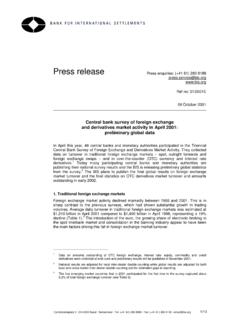

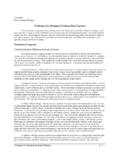

![Dif In Dif Slides.ppt [Repaired] - Wharton Finance](/cache/preview/e/2/9/5/4/6/1/8/thumb-e29546186543c246a2365bc5cbc8c9a4.jpg)
